Porcelain Insulator News
by Elton Gish
Reprinted from "Crown Jewels of the Wire", July 1994, page 11
NEW BOOK!!!
My new book, Fred M. Locke. A Biography, is now available. See the full page
advertisement in the back of this issue for details on ordering either the
soft bound book or the limited edition hard bound version (less than 75 copies
available). The 8-1/2 x 11 inch size book is printed on slick magazine paper.
The 343 pages are chocked full of old photographs, illustrations, and
advertisements, most of which have never been published. Photographs and
drawings of each style of Fred Locke's glass and porcelain insulator specimens
ate shown in the appendixes, as well as details of each Fred Locke marking on
porcelain insulators and the styles they are found on. There are many old
photographs of his unique glass insulators produced during the 1910's! All of
his 61 patents are illustrated and discussed in detail. Several "new"
Fred Locke patents were discovered during my research, one of which was a metal
ram's horn design for CD 289.9. Amazingly, after he retired in 1904 his greatest contribution was
made and patented in
1925, and it had nothing to do with porcelain insulators. It is used every time
a Space Shuttle is launched, and you may be using it in your home, too.
If you
are interested in the Fry Glass Co. or the Corning Glass Works, the book will
reveal to you an amazing connection with Fred Locke. Do you know what glass
formula was used to make the Fry insulators? Do you know why some of Fred
Locke's glass insulators have the marking, "F. M. LOCKE & CO." and
others have the "& CO." blotted out?
I have been interested in
Fred Locke since 1970 when I found many trade journal articles from the 1890's
and 1900's advertising his glass and porcelain insulators. Just who was this man
and how was he able to attain prominence in the insulator industry in such a
short time (1892-1904)? He "retired" in 1904 after a short career
designing, marketing and manufacturing insulators. The last four years of
intensive research have answered many questions and resulted in the entire previously sketchy history
of Fred Locke being completely rewritten. Why did he "retire" and what
did he do all those years until his death in 1930? What was his family like? Who
really made the under-glaze ink marked porcelain insulators (hint -- it was not
Imperial)? Did you know that Fred Locke was an accomplished angler, fly maker,
and professional photographer, and that he had interests in astronomy and making
artificial gemstones? He also had glass pin-type and suspension insulators
manufactured in the 1910's. Did you know that one of Fred Locke's sons had an
invention that allowed the television to be mass produced, thus making it
affordable to the general public?
Never before has so much information been
published about an individual so important to the insulator industry as Fred
Locke. This book provides a whole new perspective on the life of the inventive
genius, Fred Locke, who is known as "The Father of Porcelain
Insulators". At last, the facts behind the legends are revealed!
- - - - - - - - - - - -
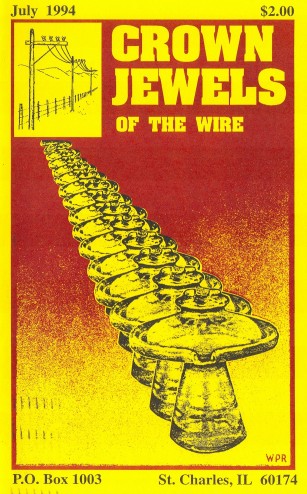
(Large Image - 332 Kb)
(Cover Page)
I want to express my thanks to Walter Ruedrich (NIA #3290) for his fine cover
design this month. One of his favorite insulators, as mine, is M-2795. We
thought his cover design was most appropriate to announce the publication of my
new book. M-2795 ("Victor" No. 316) was one of a series of Fred
Locke's "Victor" insulator styles which we discussed in September 1990 and April 1991
CJ. Twelve pages in my book are devoted to M-2795 and many
more for the "Victor" styles.
M-2795 (porcelain eaves trough and spout
with glass bottom skirt) was used on two world famous power lines in northern
California. The Bay Counties Power Co. constructed a double circuit from the
hydroelectric plant at Colgate on the Yuba River to Oakland, a distance of 152
miles, and on to San Francisco by way of the Standard Electric Co. line, for a
total of 222 miles. The Standard Electric Co. constructed a single circuit from
Electra on the Mokelumne River to Oakland and San Francisco, a distance of 219
miles.
John Martin, Fred Locke's west coast selling agent, was one of the
backers of the Bay Counties line. Prince Poniatowski was the major backer for
the Standard Electric Co. line. Both lines were to be operated at 44,000 volts
because of the long distances. However, none of the insulator suppliers or
manufacturers would agree to supply the insulators saying that no insulator had
yet been made that would safely operate above 30,000 volts. John Martin
discussed the problem with Fred Locke and he agreed to meet with the prince and
C. C. Chesney at the Stanley Electric Co.' s office in Pittsfield, MA. Mr.
Chesney's young assistant, Richard Sterling, had been working on a design for
large capacity insulators and was granted a patent on March 14, 1900 for the
design we know as M-2795.
Fred Locke suggested a few modifications based on his previous experimental results. He
agreed to undertake the job of manufacturing the insulators after John Martin
offered to supply the capital needed for Fred to construct two new kilns and an
electrical testing room. Hard feelings were generated between the Standard
Electric Co. and Fred Locke when he claimed credit for the insulator design in a
1901 trade journal. His claim was based on a couple of patents and his use of
the glass bottom skirt. Details of this interesting conflict and photographs of
the construction and interior of the testing room can be found in my book.
Work
began immediately and the first insulators were shipped in June 1900. There are
several original photographs (most not previously published) in my book (Chapter
7) which show various views of the Victor factory with 20,000 tops for M-2795
piled outside and insulators being tested inside the testing room. The earliest
M-2795's were marked on the porcelain top shell with marking #1-5:
(Front side)
F. M. LocKE
PAT
DEC. 15. 96
(Back side)
303
VICTOR
A few specimens with the "303" marking are known and were among the
first M-2795' s produced by June 1900. Starting about November 1900, marking #1-5 was replaced by various 4-date markings. These
insulators had the manufacturing date stamped on the opposite side with the word
"VICTOR". The earliest known manufacturing date is "NOV 21
1900" and the latest date is "DEC 4 1901". M-2795's with Fred
Locke marking #6-2 were made after December 1901. A few M-2796's (porcelain eave
trough and spout with porcelain bottom skirt) may have been used on the two
northern California lines, but the vast majority of the insulators were
M-2795's.
Maybe one third of the M-2795 specimens have the original sulfur
cement. Based on these specimens, it appears that the earlier insulators had
unmarked glass bottom skirts. I have one specimen dated "June 3 1901"
with original sulfur cement and an unmarked glass bottom skirt. The only
specimen that I have seen with original sulfur cement and dated glass bottom
skirt had the manufacturing date of "NOV 29 1901" after he retired in
1904. Therefore the glass bottom skirts with patent dates must have been first
used in the later half of 1901. The marking on the glass bottom skirt is
"LOCKE'S PAT'S DEC. 15-96 JUNE 7-98". In contrast, the glass bottom
skirt for CD 342 has the marking "LOCKE PAT DEC. 15-96 JUNE 7-98".
Note the missing "S" on "LOCKE" and "PAT".
The
next photograph shows two more "Victor" styles. The one on the left is
the famous M-2335 ("Victor" No. 306). It has a porcelain top skirt,
two spouts on opposite sides to direct water from the eave trough, and a porcelain bottom skirt. The
insulator on the right is the only known specimen of M-2336 ("Victor"
No. 304). It has a porcelain top skirt with two spouts and a glass bottom skirt
with an embossed "B" marking, which indicates that Brookfield made
them. It appears that the crown of M-2336 was cut off after it was glazed and before it was fired. It has the manufacturing
date of "APR. 10 190?". The year was surely 1901. This exact specimen,
with crown removed, was shown in a photograph that appeared in a Locke
advertisement in the October 18, 1941 issue of Electrical World.
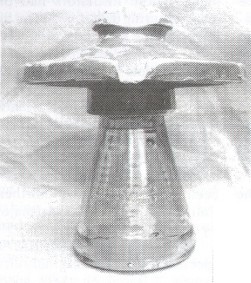 |
M-2795
Porcelain Top
with Glass Bottom
|
|
M-2796
Porcelain Top
and Bottom
|
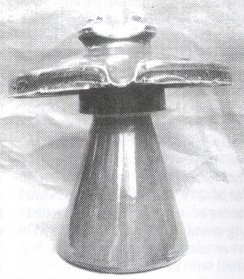 |
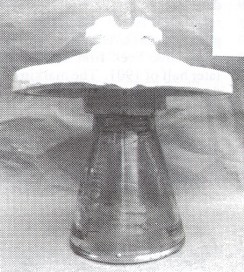 |
Only known specimen of M-2795 with a white porcelain top skirt.
|
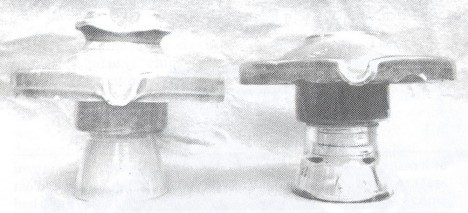
M-2335 two-spout (left) and M-2336 two-spout (right)
Note that the crown of
M-2336 was cut off.
The next insulator is a new report by Mike Bliss (NIA #109). This insulator
was used on a line in northwest Montana above the town of Butte. It was taken
from the line about 24 years ago. At first glance you might think that this
insulator is the two-spout style M2335, but it only has one spout!! This
variation of "Victor" No. 306 has been assigned M-2335A. The
dimensions of this lone specimen are, 7-1/4" - 3-1/4" x 6", which
is identical to M-2335 with the exception that it is one-half inch shorter. It
has Fred Locke marking #6-2. This insulator was probably a revision of the
two-spout style since one spout would obviously be easier to manufacture, and the 6-date marking was used after the
4-date markings found on the two known M-2335's.
The result of Fred Locke's
third attempt at designing a porcelain/ glass combination insulator was the
"Victor" insulator, such as M-2795. A chapter in my book explains in
detail why he developed a combination insulator. His first combination design
was patented on December 15, 1896. These insulators were manufactured for Fred
by the Imperial Porcelain Works. However, no specimens of this design exist
since it was a total failure. Several photographs of these insulators can be
found in Chapter 5 of my book, Fred's second attempt at producing a porcelain/glass insulator was
produced after June 1898 and before the introduction of the "Victor"
styles in June 1900. This second version of combination insulators was made for
Fred Locke by a company other than Imperial. This company produced the porcelain
insulators with the under-glaze ink markings. The name of that company will be
revealed in my book. The only known example of an insulator of this type (without
the glass bottom skirt) is U-942.
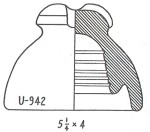
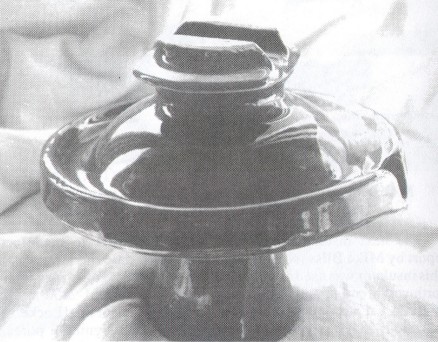
The only known specimen of M-2335A has just one spout.
| 